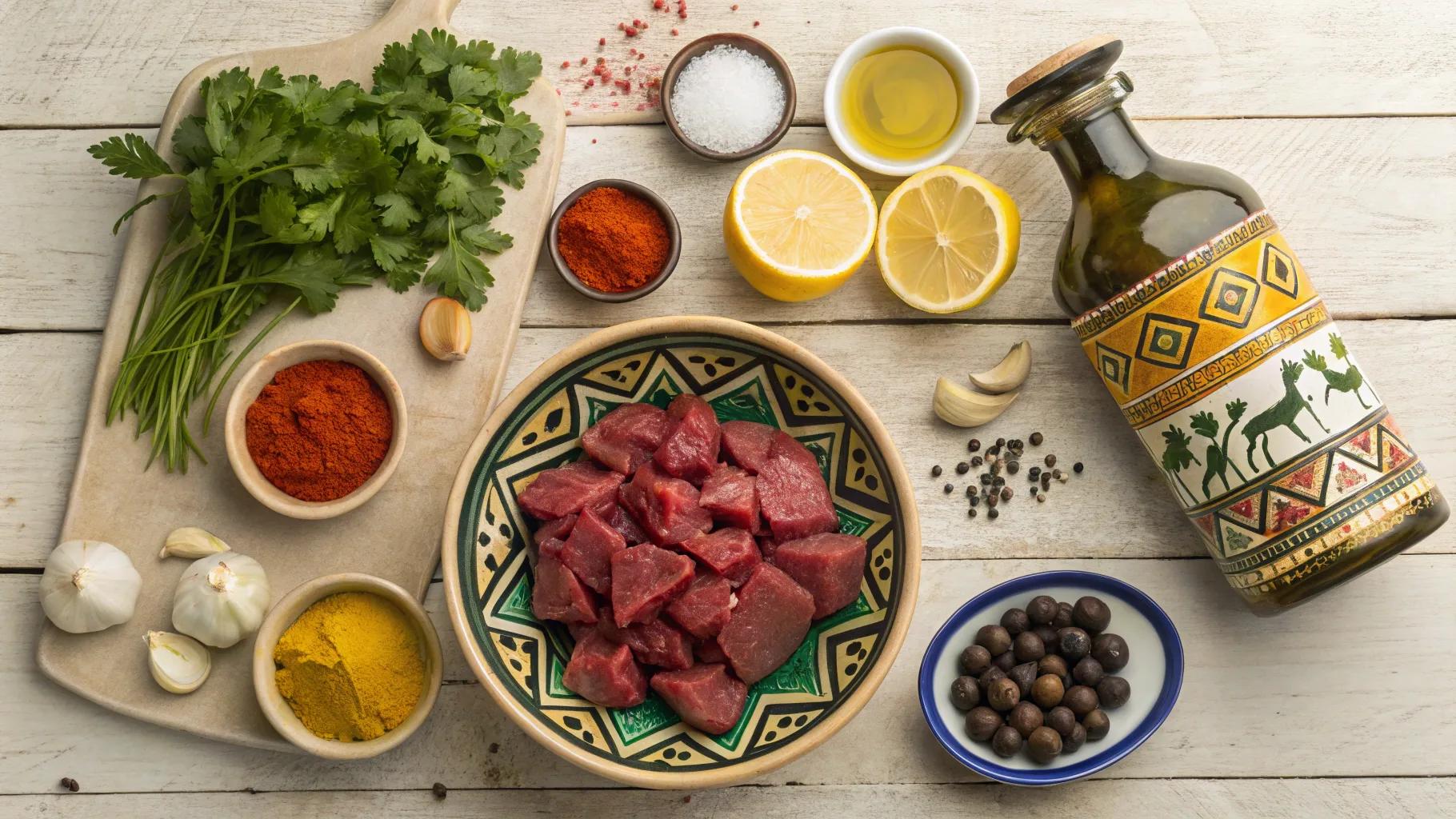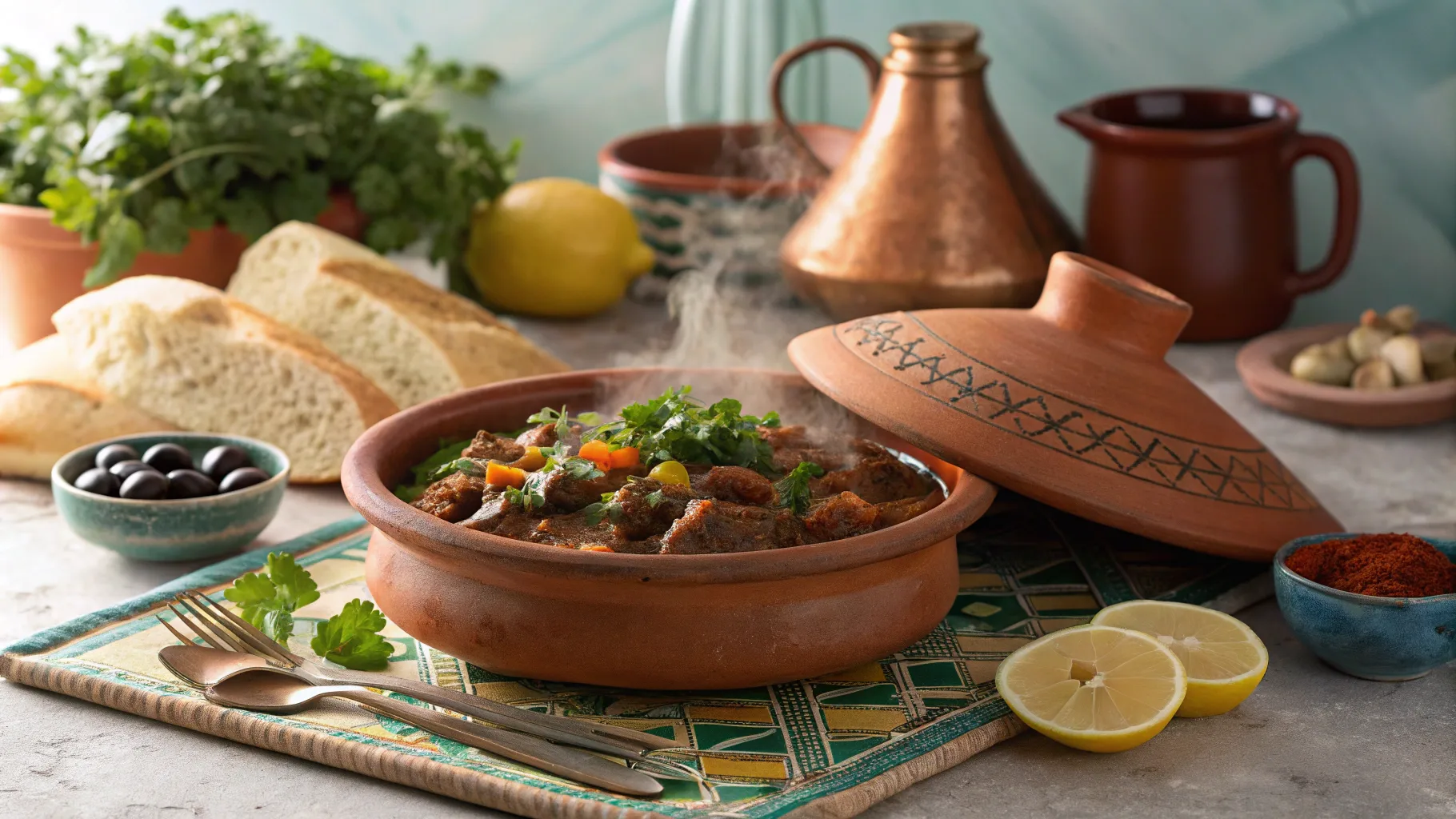Imagine standing in the heart of Marrakech’s ancient medina, where centuries-old stone walls whisper tales of culinary mastery. The air carries whispers of cardamom and preserved citrus, drawing you toward a traditional hammam where local artisans retrieve clay vessels containing Morocco’s most celebrated treasure –Moroccan Tanjia Marrakech. This isn’t merely sustenance; it represents a living testament to patience, tradition, and the transformative power of simplicity.
Your culinary adventure begins now as you discover the secrets behind creating this legendary dish within your own kitchen walls.
Understanding Tanjia Marrakech: Morocco’s Ancient Culinary Masterpiece
The Heritage Behind This Timeless Recipe
Tanjia Marrakech traces its roots back eight centuries, emerging from the creative necessity of Marrakech’s unmarried men who needed nourishing meals without complex preparation. These bachelors would gather their ingredients, seal them within clay vessels, and deliver them to local hammam operators who would nestle the pots among glowing coals for hours of gentle cooking.
This remarkable cooking method transforms humble ingredients into something extraordinary through patience and traditional wisdom. Unlike its cousin the tagine, Tanjia embraces minimalism – relying on just a handful of premium ingredients to create layers of complex flavor that dance across your palate.
Why Tanjia Stands Apart
The genius of Tanjia lies in its restraint. While modern cooking often emphasizes complexity, this ancient technique proves that exceptional results emerge from respecting each ingredient’s natural character. The clay vessel creates a unique environment where moisture circulates, meat fibers break down slowly, and spices meld into harmonious unity.
Essential Equipment and Premium Ingredients for Success
Choosing Your Cooking Vessel
Traditional clay pots remain the gold standard for authentic results, though modern alternatives work beautifully. A heavy Dutch oven with tight-fitting lid creates similar conditions, trapping steam and maintaining consistent temperature throughout the extended cooking process.
Season new clay vessels by soaking them overnight, then heating gradually to prevent cracking. This preparation step ensures your pot will serve you faithfully for years of delicious meals.
Premium Ingredient Selection

| Component | Specification | Quantity | Selection Notes |
|---|---|---|---|
| Protein | Lamb shoulder or beef chuck | 2 pounds | Marbled cuts work best |
| Preserved Lemons | Traditional Moroccan style | 2-3 pieces | Homemade preferred |
| Ras el Hanout | Freshly ground blend | 2 teaspoons | Quality makes difference |
| Fresh Ginger | Ground fine | 1 teaspoon | Warmth and depth |
| Turmeric | Pure powder | 1/2 teaspoon | Golden color and earth |
| Garlic | Large fresh cloves | 4-5 pieces | Aromatic foundation |
| Smen | Aged clarified butter | 2 tablespoons | Richness and tradition |
Source your preserved lemons from specialty Mediterranean markets, or create your own by packing fresh lemons with coarse salt for four weeks. The tangy, complex flavor they provide cannot be replicated with fresh citrus alone.
How to Make Authentic Moroccan Tanjia Marrakech: Your 5-Step Journey
Step 1: Preparing Your Foundation (15 Minutes)
Begin by selecting meat with natural marbling – these fat streaks will melt during cooking, creating incredible tenderness. Cut your protein into substantial chunks, roughly three inches per piece. Smaller cuts will overcook, while larger pieces won’t cook through properly.
Season generously with coarse sea salt, allowing the crystals to draw out moisture initially before being reabsorbed along with the salt’s flavor. This technique, called dry-brining, intensifies taste while improving texture significantly.
Crush your garlic cloves gently, releasing their aromatic oils without creating a paste. You want distinct pieces that will soften and sweeten during the long cooking process.
Step 2: Building Your Spice Symphony (10 Minutes)
Toast your ras el hanout blend in a dry pan for thirty seconds, just until fragrant. This brief heating awakens dormant flavors and creates deeper complexity in your finished dish. Watch carefully – burnt spices turn bitter and ruin everything.
Combine the warmed spice blend with ground ginger and turmeric, creating a fragrant mixture that will coat your meat evenly. The golden turmeric provides both color and earthy depth, while ginger adds warming heat that builds gradually.
Step 3: Masterful Assembly Technique (20 Minutes)
Layer your seasoned meat pieces in the bottom of your cooking vessel, creating a single layer when possible. Nestle garlic pieces between the meat, ensuring even distribution throughout.
Sprinkle your spice mixture over everything, followed by small pieces of preserved lemon distributed evenly. The citrus will break down during cooking, infusing every bite with tangy brightness that balances the rich meat perfectly.
Add your smen or clarified butter in small dots across the surface. This fat will render slowly, basting the meat naturally throughout the cooking process.
Pour just enough water to create steam – approximately half a cup maximum. Too much liquid creates stew instead of the concentrated flavors you’re seeking.
Step 4: The Patient Art of Slow Cooking (4-6 Hours)
Seal your vessel completely using aluminum foil pressed tightly around the rim, then cover with the lid. This double-sealing prevents precious steam from escaping during the extended cooking time.
Set your oven to 300°F (150°C) – low enough for gentle cooking but sufficient to maintain the necessary steam environment. Place your sealed pot in the center of the oven, away from heating elements.
Resist the temptation to peek during cooking. Each time you break the seal, you release accumulated steam and extend cooking time. Trust the process – your kitchen will fill with incredible aromas that signal success.
After four hours, test doneness by checking if meat falls apart easily with a fork. Tough cuts may require an additional hour or two. Properly cooked Tanjia meat should be fork-tender while retaining its shape.
Step 5: The Ceremonial Unveiling and Serving (15 Minutes)
Remove your pot from the oven and allow it to rest for ten minutes before breaking the seal. This resting period allows juices to redistribute and temperatures to equalize slightly.
When you remove the foil and lid, aromatic steam will escape – breathe deeply and savor this magical moment. The meat should glisten with rendered fat and aromatic juices, while preserved lemon pieces will have softened into jammy sweetness.
Serve immediately while piping hot, accompanied by fresh Moroccan bread for sopping up the precious cooking juices. Traditional mint tea provides the perfect beverage pairing, cleansing the palate between rich, satisfying bites.
Professional Tips for Tanjia Perfection
Common Pitfalls to Avoid
Never overcrowd your cooking vessel – meat pieces need space for proper heat circulation. Using excessive liquid creates braised meat instead of the concentrated flavors that define authentic Tanjia.
Maintain consistent oven temperature throughout cooking. Fluctuating heat creates uneven results and can make meat tough despite long cooking times.
Advanced Techniques from Marrakech Masters
Traditional cooks often wrap their clay pots in wet newspaper before sealing, creating additional steam during the initial heating phase. This technique works beautifully with modern adaptations too.
Some master cooks add a single cinnamon stick or few cardamom pods for subtle warmth, though purists argue against any additions beyond the essential ingredients.
Creating the Complete Tanjia Experience
Traditional Accompaniments
Serve your Tanjia with warm, pillowy Moroccan bread that guests can tear by hand. The bread becomes a utensil for gathering every drop of the precious cooking juices.
Prepare simple salads featuring tomatoes, cucumbers, and fresh herbs dressed with olive oil and lemon juice. These bright flavors provide refreshing contrast to the rich, slow-cooked meat.
Cultural Context and Sharing
Tanjia represents communal dining at its finest. Place the cooking pot in the center of your table, allowing everyone to serve themselves directly. This family-style presentation honors the dish’s social heritage while creating intimate dining experiences.
Share stories during your meal – Tanjia tastes best when accompanied by conversation, laughter, and connection with those around your table.
Preserving and Enjoying Leftovers
Store cooled Tanjia in refrigerator for up to four days, though the flavors actually improve overnight as spices continue melding. Reheat gently in low oven, adding a splash of water if needed to restore moisture.
Leftover meat makes excellent filling for sandwiches or grain bowls, extending your Moroccan feast across multiple meals.
Your Culinary Adventure Awaits
Mastering authentic Moroccan Tanjia Marrakech connects you with centuries of culinary wisdom while creating new memories around your own table. Each preparation teaches patience, respect for quality ingredients, and the magic that happens when you allow time to work its transformative power.
Your journey into Moroccan cuisine begins with this single dish, but it opens doors to an entire world of flavors, techniques, and cultural appreciation that will enrich your cooking forever.
Ready to start your Tanjia adventure? Gather your ingredients, embrace the process, and prepare to amazement your family and friends with this incredible taste of Morocco. Share your results in the comments below – we’d love to hear about your first Tanjia experience and any creative adaptations you discover along the way!

